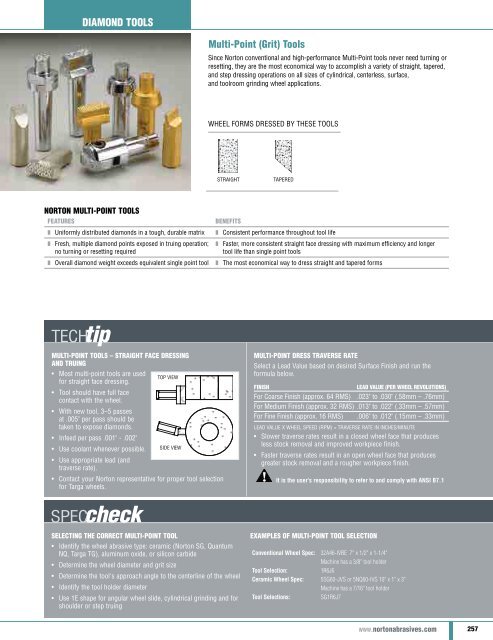You also want an ePaper? Increase the reach of your titles
YUMPU automatically turns print PDFs into web optimized ePapers that Google loves.
Diamond Tools<br />
Multi-Point (Grit) Tools<br />
Since <strong>Norton</strong> conventional and high-performance Multi-Point tools never need turning or<br />
resetting, they are the most economical way to accomplish a variety of straight, tapered,<br />
and step dressing operations on all sizes of cylindrical, centerless, surface,<br />
and toolroom grinding wheel applications.<br />
Wheel Forms Dressed by These Tools<br />
Straight<br />
Tapered<br />
<strong>Norton</strong> Multi-Point Tools<br />
Features<br />
❚❚<br />
Uniformly distributed diamonds in a tough, durable matrix<br />
❚❚<br />
Fresh, multiple diamond points exposed in truing operation;<br />
no turning or resetting required<br />
❚❚<br />
Overall diamond weight exceeds equivalent single point tool<br />
Benefits<br />
❚❚<br />
Consistent performance throughout tool life<br />
❚❚<br />
Faster, more consistent straight face dressing with maximum efficiency and longer<br />
tool life than single point tools<br />
❚❚<br />
The most economical way to dress straight and tapered forms<br />
Multi-Point Tools – Straight Face Dressing<br />
and Truing<br />
• Most multi-point tools are used<br />
toP vieW<br />
for straight face dressing.<br />
• Tool should have full face<br />
contact with the wheel.<br />
• With new tool, 3–5 passes<br />
at .005" per pass should be<br />
taken to expose diamonds.<br />
• Infeed per pass .001" - .002"<br />
• Use coolant whenever possible. side vieW<br />
• Use appropriate lead (and<br />
traverse rate).<br />
• Contact your <strong>Norton</strong> representative for proper tool selection<br />
for Targa wheels.<br />
metric<br />
Multi-Point Dress Traverse Rate<br />
Select a Lead Value based on desired Surface Finish and run the<br />
formula below.<br />
Finish<br />
lead Value (Per Wheel Revolutions)<br />
For Coarse Finish (approx. 64 RMS) .023" to .030" (.58mm – .76mm)<br />
For Medium Finish (approx. 32 RMS) .013" to .022" (.33mm – .57mm)<br />
For Fine Finish (approx. 16 RMS) .006" to .012" (.15mm – .33mm)<br />
Lead Value x Wheel Speed (RPM) = Traverse Rate in Inches/Minute<br />
• Slower traverse rates result in a closed wheel face that produces<br />
less stock removal and improved workpiece finish.<br />
• Faster traverse rates result in an open wheel face that produces<br />
greater stock removal and a rougher workpiece finish.<br />
It is the user’s responsibility to refer to and comply with ANSI B7.1<br />
Selecting the Correct Multi-Point Tool<br />
• Identify the wheel abrasive type: ceramic (<strong>Norton</strong> SG, Quantum<br />
NQ, Targa TG), aluminum oxide, or silicon carbide<br />
• Determine the wheel diameter and grit size<br />
• Determine the tool's approach angle to the centerline of the wheel<br />
• Identify the tool holder diameter<br />
• Use 1E shape for angular wheel slide, cylindrical grinding and for<br />
shoulder or step truing<br />
Examples of Multi-Point Tool Selection<br />
Conventional Wheel Spec: 32A46-IVBE 7" x 1/2" x 1-1/4"<br />
Machine has a 3/8" tool holder<br />
Tool Selection:<br />
1R6J6<br />
Ceramic Wheel Spec: 5SG60-JVS or 5NQ60-IVS 10" x 1" x 3"<br />
Machine has a 7/16" tool holder<br />
Tool Selections:<br />
SG1R6J7<br />
www.nortonabrasives.com<br />
257

















